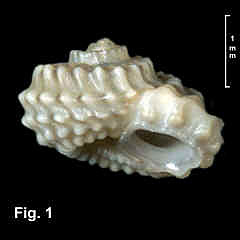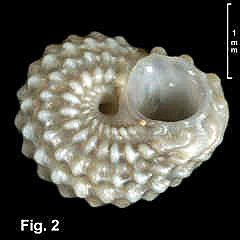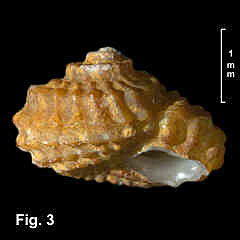|
|
TORNIDAE |
|
|
|
Pseudoliotia micans (Adams, 1850) Description: Shell low spired, thick shelled. Early whorls sharply angled, concave above shoulder, with strong nodules on shoulder. Last whorl with shoulder becoming rounded towards aperture, with reticulate sculpture of six spiral cords crossed by axial folds, with strong nodules at intersections. Aperture circular, thickened internally, interior iridescent. Umbilicus widely open, with beaded funicle. Colour grey with white on nodules (Figs. 1, 2) eroding to drab white; covered by dark brown periostracum when alive (Fig. 3), eroding to drab white. Size: Up to 3.5 mm wide. Distribution: Endemic to Australia: Cape Moreton, Queensland, southwards and around southern Australia to central South Australia, including Tasmania. Habitat: Lives on seagrass and other substrates and under rocks and debris in sheltered bays and estuaries in the lower littoral and shallow sub-littoral zones. Common. Comparison: See P. speciosa. Synonymy: Liotia angasi Crosse, 1864 is a previously recognised synonym. Remarks: This species is most commonly seen as bleached white shells in beach washup. The thick brown periostracum wears away exposing a white shell with grey markings, which seems to quickly erode to dull white. Figs. 1, 2: Simpsons Bay, Port hacking, NSW (C.326758) Fig. 3: Fishermans Bay, Port Hacking, NSW (C.326941) |
|


